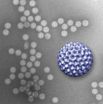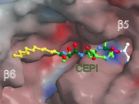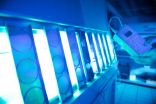(Press-News.org) CAMBRIDGE, Mass. -- Following up on earlier theoretical predictions, MIT researchers have now demonstrated experimentally the existence of a fundamentally new kind of magnetic behavior, adding to the two previously known states of magnetism.
Ferromagnetism — the simple magnetism of a bar magnet or compass needle — has been known for centuries. In a second type of magnetism, antiferromagnetism, the magnetic fields of the ions within a metal or alloy cancel each other out. In both cases, the materials become magnetic only when cooled below a certain critical temperature. The prediction and discovery of antiferromagnetism — the basis for the read heads in today's computer hard disks — won Nobel Prizes in physics for Louis Neel in 1970 and for MIT professor emeritus Clifford Shull in 1994.
"We're showing that there is a third fundamental state for magnetism," says MIT professor of physics Young Lee. The experimental work showing the existence of this new state, called a quantum spin liquid (QSL), is reported this week in the journal Nature, with Lee as the senior author and Tianheng Han, who earned his PhD in physics at MIT earlier this year, as lead author.
The QSL is a solid crystal, but its magnetic state is described as liquid: Unlike the other two kinds of magnetism, the magnetic orientations of the individual particles within it fluctuate constantly, resembling the constant motion of molecules within a true liquid.
Finding the evidence
There is no static order to the magnetic orientations, known as magnetic moments, within the material, Lee explains. "But there is a strong interaction between them, and due to quantum effects, they don't lock in place," he says.
Although it is extremely difficult to measure, or prove the existence, of this exotic state, Lee says, "this is one of the strongest experimental data sets out there that [does] this. What used to just be in theorists' models is a real physical system."
Philip Anderson, a leading theorist, first proposed the concept in 1987, saying that this state could be relevant to high-temperature superconductors, Lee says. "Ever since then, physicists have wanted to make such a state," he adds. "It's only in the past few years that we've made progress."
The material itself is a crystal of a mineral called herbertsmithite. Lee and his colleagues first succeeded in making a large, pure crystal of this material last year — a process that took 10 months — and have since been studying its properties in detail.
"This was a multidisciplinary collaboration, with physicists and chemists," Lee explains. "You need both … to synthesize the material and study it with advanced physics techniques. Theorists were also crucial to this."
Through its experiments, the team made a significant discovery, Lee says: They found a state with fractionalized excitations, which had been predicted by some theorists but was a highly controversial idea. While most matter has discrete quantum states whose changes are expressed as whole numbers, this QSL material exhibits fractional quantum states. In fact, the researchers found that these excited states, called spinons, form a continuum. This observation, they say in their Nature paper, is "a remarkable first."
Scattering neutrons
To measure this state, the team used a technique called neutron scattering, which is Lee's specialty. To actually carry out the measurements, they used a neutron spectrometer at the National Institute of Standards and Technology (NIST) in Gaithersburg, Md.
The results, Lee says, are "really strong evidence of this fractionalization" of the spin states. "That's a fundamental theoretical prediction for spin liquids that we are seeing in a clear and detailed way for the first time."
It may take a long time to translate this "very fundamental research" into practical applications, Lee says. The work could possibly lead to advances in data storage or communications, he says — perhaps using an exotic quantum phenomenon called long-range entanglement, in which two widely separated particles can instantaneously influence each other's states. The findings could also bear on research into high-temperature superconductors, and could ultimately lead to new developments in that field, he says.
"We have to get a more comprehensive understanding of the big picture," Lee says. "There is no theory that describes everything that we're seeing."
###
In addition to Lee and Han, the work was carried out by J.S. Helton of NIST, research scientist Shaoyan Chu of MIT's Center for Materials Science and Technology, MIT chemistry professor Daniel Nocera, Jose Rodriguez-Rivera of NIST and the University of Maryland, and Colin Broholm of Johns Hopkins University. The work was supported by the U.S. Department of Energy and the National Science Foundation.
Written by David Chandler, MIT News Office END
MIT researchers discover a new kind of magnetism
Experiments demonstrate 'quantum spin liquid,' which could have applications in new computer memory storage
2012-12-20
ELSE PRESS RELEASES FROM THIS DATE:
A nanoscale window to the biological world
2012-12-20
If the key to winning battles is knowing both your enemy and yourself, then scientists are now well on their way toward becoming the Sun Tzus of medicine by taking a giant step toward a priceless advantage – the ability to see the soldiers in action on the battlefield.
Investigators at the Virginia Tech Carilion Research Institute have invented a way to directly image biological structures at their most fundamental level and in their natural habitats. The technique is a major advancement toward the ultimate goal of imaging biological processes in action at the atomic ...
Production of 5-aminovaleric and glutaric acid by metabolically engineered microorganism
2012-12-20
We use many different types of chemicals and plastics for the convenience of our everyday life. The current sources of these materials are provided from petrochemical industry, using fossil oil as a raw material. Due to our increased concerns on the environmental problems and fossil resource availability, there has been much interest in producing those chemicals and materials from renewable non-food biomass through biorefineries. For the development of biorefinery process, microorganisms have successfully been employed as the key biocatalysts to produce a wide range of ...
Game changing diagnostic & prognostic prostate cancer genetic tests revealed by Jefferson
2012-12-20
PHILADELPHIA—Researchers at the Kimmel Cancer Center at Jefferson (KCC) (insert link to "Kimmel Cancer Center at Jefferson" www.kimmelcancercenter.org) have developed potentially game-changing diagnostic and prognostic genetic tests shown to better predict prostate cancer survival outcomes and distinguish clinically-relevant cancers.
The team, led by Richard G. Pestell, M.D., Ph.D., Director of the KCC and the Chair of the Department of Cancer Biology at Thomas Jefferson University, report their preclinical findings from a blinded, retrospective analysis of over 350 ...
Can observations of a hardy weed help feed the world?
2012-12-20
As the human population increases, so too do the demands and stresses on agriculture. In the January 2013 issue of International Journal of Plant Sciences, Penn State University Waller Professor of Plant Biology Dr. Sarah Assmann explores how the responses to environmental stresses by one small, genetically diverse plant species might illuminate possible approaches to addressing growing human demand for crop products amid decreasing resources.
In the article, Dr. Assmann describes how human population growth presents new challenges to twenty-first-century agriculture, ...
Serendipity points to new potential target and therapy for melanoma
2012-12-20
A University of Colorado Cancer Center study in this month's edition of the Journal of Investigative Dermatology describes a new target and potential treatment for melanoma, the most dangerous form of skin cancer. MicroRNA can decide which genes in a cell's DNA are expressed and which stay silent. Melanoma tends to lack microRNA-26a, which makes the gene SODD go silent.
"It's a double negative," says Yiqun Shellman, PhD, investigator at the CU Cancer Center, associate professor at the CU School of Medicine, and the study's co-senior author. "miR-26a works to stop the ...
Cultural, social factors identified as barriers to minority participation in stem cell donation
2012-12-20
New research examining the role of race and ethnicity in an individual's decision to become a donor for hematopoietic cell transplantation (HCT) identifies several factors associated with varied participation rates in national donor registries across racial/ethnic groups. Results of this first-of-its-kind study are published online today in Blood, the Journal of the American Society of Hematology (ASH).
Hematopoietic cell transplants serve as valuable treatments for a range of blood disorders, as they generate new, healthy blood cells to replace diseased cells. While ...
Poison for cancer cells
2012-12-20
This press release is available in German.
In their quest for new agents, pharmaceutical researchers test millions of substances all over the world. They like using color-forming reactions to identify new molecules. However, in intensively colored solutions or in the case of mixtures with multiple substances these tests fail. As part of his doctoral thesis, Martin Stein, member of staff at the Chair of Biochemistry at the Technische Universitaet Muenchen, developed a testing reaction based on magnetic resonance data. It helps find a specific pharmaceutical molecule ...
Clean air: New paints break down nitrogen oxides
2012-12-20
The Seventies: Smog alert in the Ruhr area, acid rain, dying spruce trees in the Bavarian Forest. In those days, the solution was filter systems for the smokestacks in the Ruhr area. Today, people in the urban areas are suffering from high levels of pollution that is being caused by, among other things, automotive traffic. Particularly undesired: the nitrogen oxides (NOX). In the meantime, the European Union tightened the limit values even further; in many communities they are being exceeded. Michael Hüben of the Fraunhofer Institute for Molecular Biology and Applied Ecology ...
Aldrich Materials Science discovers liquid-free preparation of metal organic frameworks
2012-12-20
St. Louis, MO – December 18, 2012 – Researchers at Aldrich Materials Science, a strategic technology initiative of Sigma-Aldrich Corporation (NASDAQ:SIAL) have discovered an innovative way to design an important class of three-dimensional (3D) hybrid structures, Metal Organic Frameworks (MOFs), under completely liquid-free conditions. High purity MOF products prepared by the liquid-free process may be ideally suited as rare earth containing materials for sensors and detectors, electronic or magnetic materials. The discovery also extends liquid-free preparation techniques ...
Pair of proteins gets brain cells into shape
2012-12-20
This press release is available in German.
The study conducted by Prof. Frank Bradke's team provides indications on brain development and about the causes of diseases of the nervous system. The results have now been published in "Neuron".
Under the microscope, the brain appears as a network of intricate beauty comprising billions of nerve cells (the so-called "neurons") linked together. This network is engaged in a constant process of sharing information. The signals are transmitted from neuron to neuron through fine ramifications of the cell body. However, to acquire ...
LAST 30 PRESS RELEASES:
Tracing the quick synthesis of an industrially important catalyst
New software sheds light on cancer’s hidden genetic networks
UT Health San Antonio awarded $3 million in CPRIT grants to bolster cancer research and prevention efforts in South Texas
Third symposium spotlights global challenge of new contaminants in China’s fight against pollution
From straw to soil harmony: International team reveals how biochar supercharges carbon-smart farming
Myeloma: How AI is redrawing the map of cancer care
Manhattan E. Charurat, Ph.D., MHS invested as the Homer and Martha Gudelsky Distinguished Professor in Medicine at the University of Maryland School of Medicine
Insilico Medicine’s Pharma.AI Q4 Winter Launch Recap: Revolutionizing drug discovery with cutting-edge AI innovations, accelerating the path to pharmaceutical superintelligence
Nanoplastics have diet-dependent impacts on digestive system health
Brain neuron death occurs throughout life and increases with age, a natural human protein drug may halt neuron death in Alzheimer’s disease
SPIE and CLP announce the recipients of the 2025 Advanced Photonics Young Innovator Award
Lessons from the Caldor Fire’s Christmas Valley ‘Miracle’
Ant societies rose by trading individual protection for collective power
Research reveals how ancient viral DNA shapes early embryonic development
A molecular gatekeeper that controls protein synthesis
New ‘cloaking device’ concept to shield sensitive tech from magnetic fields
Researchers show impact of mountain building and climate change on alpine biodiversity
Study models the transition from Neanderthals to modern humans in Europe
University of Phoenix College of Doctoral Studies releases white paper on AI-driven skilling to reduce burnout and restore worker autonomy
AIs fail at the game of visual “telephone”
The levers for a sustainable food system
Potential changes in US homelessness by ending federal support for housing first programs
Vulnerability of large language models to prompt injection when providing medical advice
Researchers develop new system for high-energy-density, long-life, multi-electron transfer bromine-based flow batteries
Ending federal support for housing first programs could increase U.S. homelessness by 5% in one year, new JAMA study finds
New research uncovers molecular ‘safety switch’ shielding cancers from immune attack
Bacteria resisting viral infection can still sink carbon to ocean floor
Younger biological age may increase depression risk in older women during COVID-19
Bharat Innovates 2026 National Basecamp Showcases India’s Most Promising Deep-Tech Ventures
Here’s what determines whether your income level rises or falls
[Press-News.org] MIT researchers discover a new kind of magnetismExperiments demonstrate 'quantum spin liquid,' which could have applications in new computer memory storage



